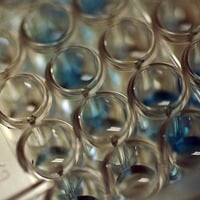 Determination of protein concentration is necessary and widely used in protein biology, molecular biology, and other research applications. The concentration of protein samples have to be estimated before proceeding to isolation, purification, and analysis. Various protein estimation methods have been developed so far. Each method has its own advantages and disadvantages over others. Most of these methods depend on the levels of tryptophan, tyrosine and other aromatic amino acids.
Determination of protein concentration is necessary and widely used in protein biology, molecular biology, and other research applications. The concentration of protein samples have to be estimated before proceeding to isolation, purification, and analysis. Various protein estimation methods have been developed so far. Each method has its own advantages and disadvantages over others. Most of these methods depend on the levels of tryptophan, tyrosine and other aromatic amino acids.
Three main factors should be considered before choosing a method.
- Sensitivity- A method is known to be sensitive if it can detect protein at very low concentrations.
- Specificity- Specificity of a method is determined by its efficiency to detect protein specifically from all other interfering substances.
- Time- Duration of time for assay completion and interpretation of results.
- Biuret method: Sensitivity of this method is very low. It requires high protein levels from 1-20 mg of protein. The reagent used in this method are Copper sulfate, Sodium hydroxide, and Potassium Sodium Tartrate. Protein reacts with this alkaline copper complex and color changes to violet. The protein can then be estimated by reading the absorption at 540nm. This method takes 20-30 minutes to complete. This method does not rely on amino acid composition and hence can measure all protein samples with accuracy. The main disadvantage of this method is that buffers with Tris, Ammonia interferes with the reaction.
- UV absorption: Sensitivity of this method is moderate. It can detect proteins in the range of 50-100 µg. In this method, no reagents are required, the liquid protein sample is monitored under UV absorption at OD 280nm. Recently, simple machinery like Nanodrop and pico drop are used where even 1 µl of the protein sample is enough to determine protein concentration. This method takes less time, within 10 minutes.
- BCA assay: This method is highly sensitive and detects proteins at a low concentration of 1 µg. In this method, Copper ions bind to Nitrogens in protein and the complex is then bound to bicinchoninic acid resulting in the change of color to purple depending on protein concentration. This method is sensitive to some chemicals. This method takes the longest time to get the end result approximately an hour. Common interfering substances are lipids, carbohydrates, Iron, impurities from glycerol etc.,
- Lowry assay: Lowry assay is one of the old methods used for protein estimation developed by Oliver Lowry (1951). This is a highly sensitive and gives accurate results. It detects proteins at low concentrations of 2-5 µg. In this method, first, the copper ions are reduced under alkaline conditions and forms a complex with peptide bonds of the protein. This complex then reduces Folin-Ciocalteau reagent and results in the change in color to deep blue and absorption can be measured at 650-750nm. It takes about 45-60 minutes for assay completion. A Compatible Lowry Assay for samples with reducing agents and other interfering agents and a Modified Lowry Assay for samples in detergents are available.
- Bradford assay: This method was developed by Marion M Bradford (1976) and widely used. This is a very sensitive method and simple dye binding assay. This method uses Coomassie brilliant blue-250 dye that binds with negatively charged protein molecules. The dye color changes based on protein concentrations and the absorption is measured at 595nm. This method takes very less time compared to other regent based assays. Within 10-15 min the results can be obtained. Using standard curve protein concentration can be estimated in no time. The main disadvantage of this method is the is less specificity to interfering substances like SDS, Triton x-100 etc. A Bradford assay with reagents to clean samples prior to assaying is also available. In addition to Coomassie blue 250 dye, other dyes like Pyrogallol red, Bromocresol green are also used for protein estimation.
References:
1. Lowry OH, Rose Brough NJ, Farr AL, Randall RJ. Protein measurement with the folin phenol reagent. J Biol Chem. 1951 Nov;193(1):265-75
2. .Bradford, M.M.# (1976),Rapid and sensitive method for the quantitation of
microgram quantities of protein utilizing the principle of protein-dye binding",# Anal. Biochem.,#72: 248–254.






